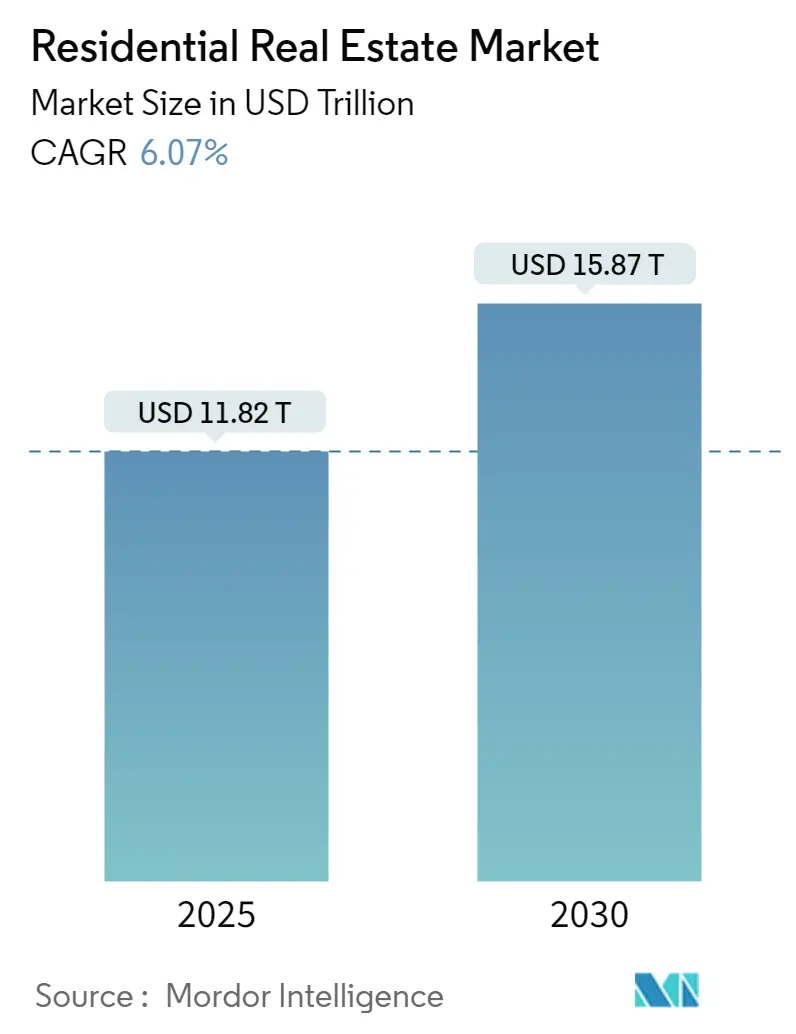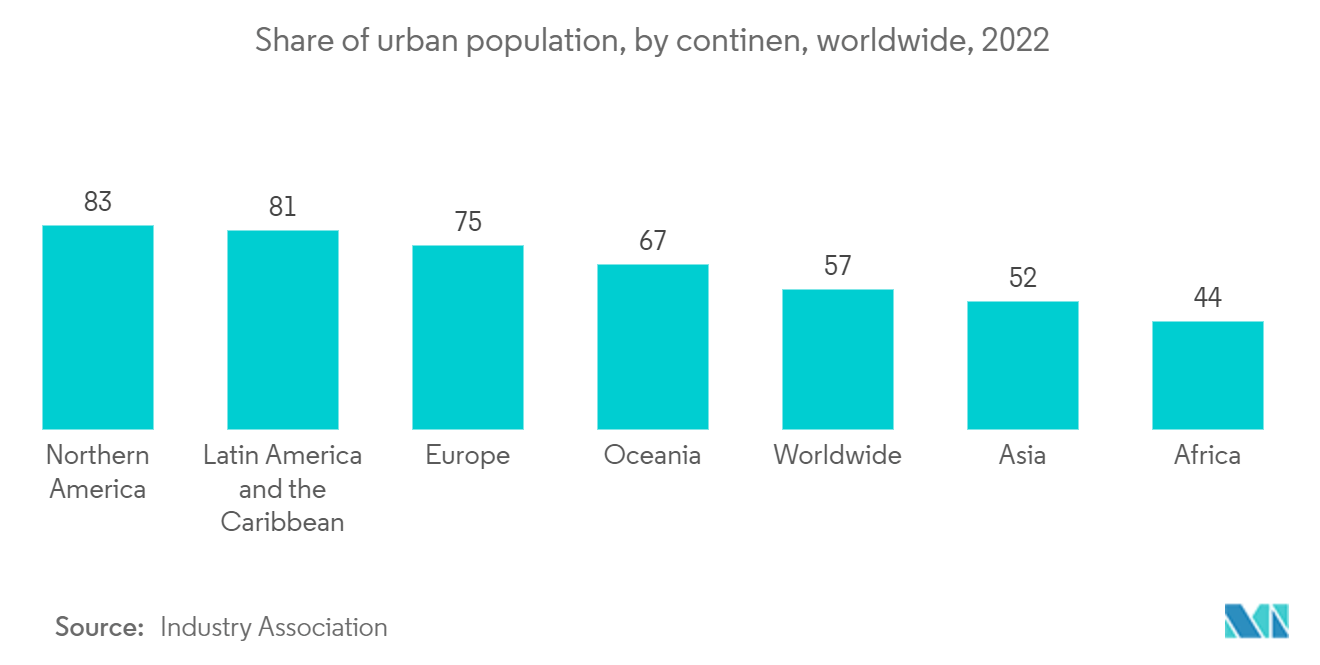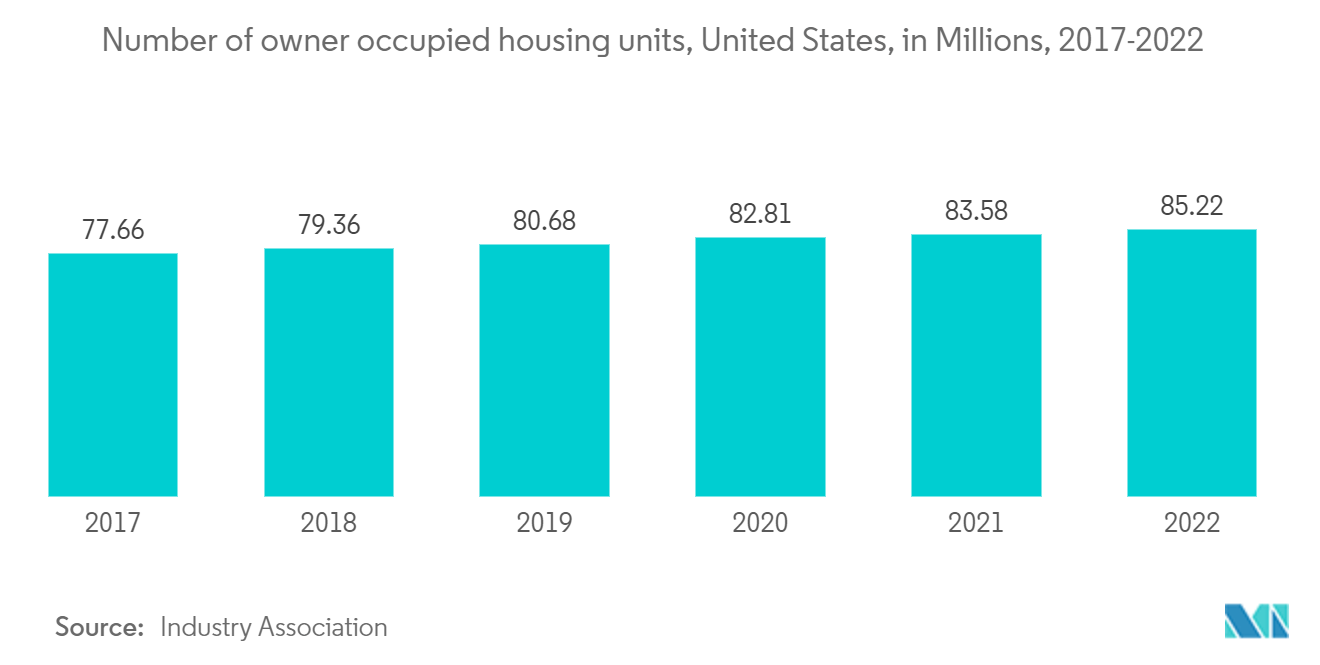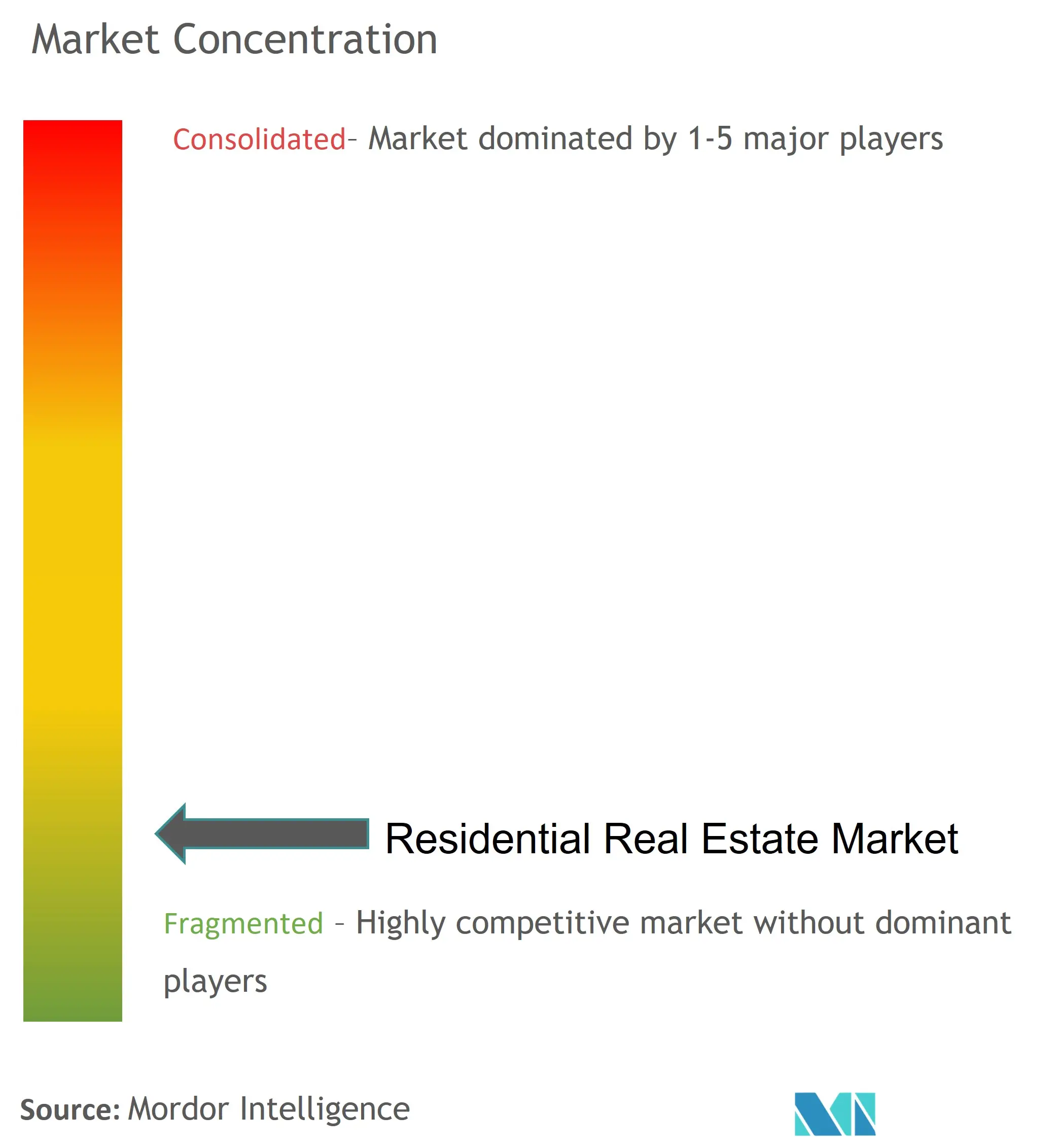Residential Real Estate Market Analysis
The Residential Real Estate Market size is estimated at USD 11.82 trillion in 2025, and is expected to reach USD 15.87 trillion by 2030, at a CAGR of 6.07% during the forecast period (2025-2030).
- The third quarter of 2022 saw an increase in economic headwinds; major economies are predicted to enter a recession in the upcoming period. However, certain nations, including those exporting commodities, are doing much better, indicating an uneven downturn. Further rate rises are projected through 2023 as central banks continue to take serious action to fight this. Occupiers are taking a more cautious approach now that decision-making processes are taking longer and, in some circumstances, standards are being lowered. These factors have decreased invest r confidence and transaction volumes in capital markets.
- The cost of newly listed homes in the United States has increased by 26.5% since March 2020 and 13.5% since the same period in 2021. Prices have cl bed by 9.1% in major urban regions like New York, Chicago, and Dallas/Fort Worth. The median active listing price in March 2022 was USD 405,000, an 8% rise from the median active listing price in the same month the previous year.
- The nationwide inventory of active listings fell by 18.9% due to the rising demand. This real estate statistic shows that more people are looking for homes than available homes for sale, a situation known as a seller's market, which raises prices and causes a shortage.
- Furthermore, government measures in promoting affordable housing stimulate market expansion. Governments in Australia, the United States, and Canada have planned strategies such as concessions for first-time buyers, veterans' subsidies, a golden visa, low-cost affordable housing schemes, and a reduction in transactional taxes, all of which are expected to boost growth in the residential real estate market. Even the low m mortgage interest rates fuel the residential real estate market in countries like the United States, Canada, India, and Australia.
Residential Real Estate Market Trends
Increased urbanization and homeownership by elderly
- Approximately 4.4 billion people, or 56% of the world's population, now reside in cities. By 2050, approximately 7 out of 10 people will live in cities, with the urban population predicted to surpass its current level. Nevertheless, the speed and scale of urbanization present difficulties, such as meeting the increased demand for affordable housing and functional infrastructure, including transportation systems, essential services, and jobs, particularly for the nearly 1 billion urban poor who live in informal settlements to be close to opportunities.
- In the United States, 75.3% of persons between the ages of 55 and 64 and 79.4% of people over 65 are homeowners. People under 35 had the lowest homeownership rate, with 38.3%.
- Gen X, born between 1965 and 1979, makes up the majority of American homebuyers (24%). They are the largest generation in terms of home sales. At 23%, older millennials (born between 1980 and 1989) are the second-largest homebuyers. While the younger generations tend to buy more frequently, the older generations predominately sell.
- According to experts, the ongoing rise of tall structures is a necessary component of the urban sustainability agenda as a housing solution. Major skylines are changing quickly in urban centers all around the world right now. The degree of development in cities like Shanghai, Shenzhen, Hong Kong, Dubai, Riyadh, Mumbai, and London, to name a few, is evidence of the diversity of these worldwide trends. The majority of development is taking place in the GCC and Asia's expanding economies.
Increase in residential properties across the United States due to less mortgage rates
- When mortgage rates are low, it becomes more affordable for people to borrow money to purchase homes. Lower mortgage rates mean lower monthly mortgage payments, which can make homeownership more accessible to a larger number of people. This increased affordability can lead to a higher demand for residential properties.
- Lower mortgage rates often stimulate activity in the housing market. Potential homebuyers, motivated by the opportunity to secure a lower interest rate, may be more inclined to enter the market and purchase a property. This increased demand can contribute to an overall increase in residential property sales.
- Lower mortgage rates not only attract new homebuyers but also incentivize existing homeowners to refinance their mortgages. Refinancing allows homeowners to replace their current mortgage with a new one that has a lower interest rate. This can result in reduced monthly mortgage payments or even cash-out refinancing, where homeowners take advantage of the lower rates to access additional funds for other purposes.
- The increased demand for residential properties due to lower mortgage rates can also influence the construction and development sector. Developers and builders may respond to the demand by initiating new residential projects to meet the needs of potential homebuyers. This can lead to an increase in the supply of residential properties in certain areas.
- Mortgage rates are influenced by various economic factors, such as inflation, monetary policy, and market conditions. When mortgage rates decrease, it can be an indicator of a more accommodative monetary policy or a slower economy. Lower mortgage rates can stimulate economic activity by encouraging consumer spending and investment in the housing market.
- It's important to note that the impact of lower mortgage rates on residential properties can vary across different regions within the US. Factors such as local housing market conditions, employment rates, and population growth can influence the extent to which lower mortgage rates drive an increase in residential property activity.
Residential Real Estate Industry Overview
The residential real estate market is fragmented and highly competitive, with the presence of regional and international players. International MNCs include Savills PLC and Sun Hung Kai Properties. The regional players dominate their respective countries, like DLF in India and KB Homes in the United States. Major companies in the market have adopted strategies such as acquisitions, business developments, joint ventures, partnerships, and product launches to offer better services to customers in the residential real estate market. For instance, in 2021, Savills formed a strategic alliance with SRS Real Estate Partners. In 2021, Lennar Group acquired RealStar Homes, a privately-held Coastal Carolinas operator, to expand the market.
Residential Real Estate Market Leaders
-
Christie International Real Estate
-
ColdWell Banker Real estate Company
-
Al Habtoor Group
-
DLF Ltd
-
Hochtief Corporation
- *Disclaimer: Major Players sorted in no particular order
Residential Real Estate Market News
- December 2023: The Ashwin Sheth group is planning to expand its residential and commercial portfolio in the MMR (Mumbai Metropolitan Area) region, India.
- November 2023: Tata Realty and Infrastructure, a wholly-owned subsidiary of Tata Sons, plans to grow its business with more than 50 projects in major cities in India, Sri Lanka and the Maldives. The projects have a development potential of more than 51 million square feet.
Residential Real Estate Industry Segmentation
Residential real estate is an area developed for people to live. As defined by local zoning ordinances, residential real estate cannot be used for commercial or industrial purposes. A complete background analysis of the Residential Real Estate Market, including the assessment of the economy and contribution of sectors in the economy, market overview, market size estimation for key segments, and emerging trends in the market segments, market dynamics, and geographical trends, and COVID-19 impact is included in the report.
The Residential Real Estate Market is segmented by type (apartments and condominiums and landed houses and villas) and geography (North America, Europe, Asia-Pacific, Middle East & Africa, Latin America, and the Rest of the World). The report offers the market sizes and forecasts for the Residential Real Estate market in value (USD) for all the above segments.
| Type | Apartments and Condominiums | ||
| Landed Houses and Villas | |||
| Geography | North America | United States | |
| Canada | |||
| Europe | United Kingdom | ||
| France | |||
| Germany | |||
| Rest of Europe | |||
| Asia-Pacific | China | ||
| India | |||
| Japan | |||
| South Korea | |||
| Australia | |||
| Rest of Asia-Pacific | |||
| Middle East & Africa | United Arab Emirates | ||
| Saudi Arabia | |||
| South Africa | |||
| Rest of Middle East & Africa | |||
| Latin America | Brazil | ||
| Argentina | |||
| Rest of Latin America | |||
| Rest of the World | |||
Residential Real Estate Market Research FAQs
How big is the Residential Real Estate Market?
The Residential Real Estate Market size is expected to reach USD 11.82 trillion in 2025 and grow at a CAGR of 6.07% to reach USD 15.87 trillion by 2030.
What is the current Residential Real Estate Market size?
In 2025, the Residential Real Estate Market size is expected to reach USD 11.82 trillion.
Who are the key players in Residential Real Estate Market?
Christie International Real Estate, ColdWell Banker Real estate Company, Al Habtoor Group, DLF Ltd and Hochtief Corporation are the major companies operating in the Residential Real Estate Market.
Which is the fastest growing region in Residential Real Estate Market?
Asia-Pacific is estimated to grow at the highest CAGR over the forecast period (2025-2030).
Which region has the biggest share in Residential Real Estate Market?
In 2025, the Asia-Pacific accounts for the largest market share in Residential Real Estate Market.
What years does this Residential Real Estate Market cover, and what was the market size in 2024?
In 2024, the Residential Real Estate Market size was estimated at USD 11.10 trillion. The report covers the Residential Real Estate Market historical market size for years: 2019, 2020, 2021, 2022, 2023 and 2024. The report also forecasts the Residential Real Estate Market size for years: 2025, 2026, 2027, 2028, 2029 and 2030.
Our Best Selling Reports
Residential Real Estate Industry Report
The residential real estate market, encompassing the buying and selling of properties such as flats, bungalows, and villas, is projected to experience significant growth in the coming years. This expansion is primarily fueled by urbanization in developing countries, where rapid city development and migration are escalating the demand for residential properties. Government policies that promote affordable housing, including concessions for first-time buyers, subsidies for veterans, and low-cost housing schemes, are further driving the market growth. Despite these positive factors, the market faces challenges due to saturation in major cities of developed nations. The market is segmented by budget and size, with notable growth anticipated in the mid-range budget segment and the smaller size segment. According to Mordor Intelligence™ Industry Reports, the Residential Real Estate market share, size, and revenue growth rate are provided, along with a market forecast outlook and a historical overview. A sample of this industry analysis is available as a free report PDF download.







